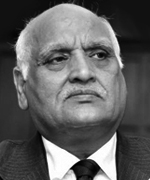Guts, Grit and Glory | Army Deserves the Best
 Maj. Gen. Raj Mehta (retd)
Maj. Gen. Raj Mehta (retd)
Almost neutered by an ever-escalating pensions’ bill consuming over 60 per cent of a comatose, declining defence budget with reducing purchasing power pegged currently at 1.46 per cent of the Gross Domestic Product (GDP), the pensions’ bill is a soldier’s welfare obligation that leaves little for capital defence purchases. Governments over decades have fielded scheme after unsuccessful ad hoc scheme to make defence allotment of money count towards new acquisitions and stem this stark ‘welfare-over-defence preparedness’ conundrum that confronts us.
Tour of Duty (ToD), has deliberately been floated as a pilot project which is currently restricted to the Infantry arm of the Indian Army (less Para SF and other forces like NSG). The proposed three-year, cynically titled by some commentators as a ‘use and discard’ officer and soldier money-saving, scheme anchors itself on the conviction that India’s teeming millions of unemployed male youth will aggressively seek a short tour in the battle zone as members of their glamorous and brave army and experience at first hand that macho feeling of war and war-fighting for India before returning to civil life with a ‘Badge of Honour’ which hopefully will have corporate employment value.
The question is will it yield the financial and operational gains that the government expects it to harness for better military effectiveness and defence budget management?. Or are there better ways of doing this?
The Idea of ToD
Bluntly stated, the sole genesis of the Tour of Duty (ToD) issue is India’s exploding defence pensions’ bill. There is no other great or noble country-first intent behind its fielding. In the absence of ministry of defence (MoD) transparency on the issue, one struggles to fathom what is behind this radical oxymoron of ‘volunteer conscription’ of under-graduate males immediately after 10+2 (18-21-year-olds). Inducted into the Infantry (because it is supposedly a ‘non-technical’ arm) using exacting selection norms and trained cursorily for six months, they will enter the war zone for three year tenures and thereafter be disposed of with minimal severance and nil attendant terminal benefits such as medical, education, employment or job reservation benefits.
The prime motivation could be the background work on military pensions management done by the duo of retired Lt Gen. Prakash Menon and Pranay Kotasthane. Their 2019 paper, ‘A Human Capital Investment Model for India’s National Security System’, seems to be one major input using which the newly-formulated Department of Military Affairs (DMA) in MoD headed by the CDS/Secretary has chosen to tackle our exploding defence pension expenditure by proposing the TOD offering. (Read the paper at https://takshashila.org.in/takshashila-discussion-document-a-human-capital-investment-model-for-indias-national-security-system/)
The paper states that India’s defence pensions’ expenditure is unsustainable and has ballooned after the implementation of the One Rank One Pension (OROP) scheme. It states that in the long run, the pension component will make the defence budget irrelevant, consuming most of it and, in the short run, it is severely degrading defence modernisation. As overwhelming proof, the paper says that the pensions’ bill of Rs 54,000 crore in 2014 has more than doubled to Rs1, 12,000 crore in 2020.
It candidly accepts that starting with the Kargil Review Committee (KRC) Report, many solutions have been floated to address this problem but none of them have fructified or, on fielding, have defeated the very purpose for which the solutions were offered in the first place. The fielding of Short Service Commissions (SSCs) for officers for five years is touted as an example wherein the initial period of five years was expanded to 10 years and then 14, extended on Supreme Court’s directions to women officers’ entry schemes also.
Against that backdrop both stated and implied the paper proposes lateral movement of armed forces personnel into the national security system to contain the defence pensions’ expenditure and estimates that the government can achieve savings of Rs 1.2 lakh crores if this model is implemented.
Readers can now hopefully see the deep linkages between the pensions issue and the TOD recruitment plan.
A word about the authors is warranted here. Commissioned in 1972, Gen. Menon is director, strategic studies at a privately funded think tank, Takshashila, and adjunct professor NIAS, Bangalore. He has been military advisor to NSA/secretary to government of India (GOI) and officer on special duty (OSD) in NSCS. He is the author of Non Alignment 2.0: A Foreign and Strategic Policy for India in the 21st Century which became a much-commented-upon policy paper in media and defence circles. Pranay Kotasthane is a VLSI professional who is research head at Takshashila since 2017 and writes on geopolitics, public finance, public policy and co-hosts a podcast.
Thus, both work for the same private think tank, Takshashila. Kotasthane recently teamed interactively in a well synchronised podcast with Gen. Menon on the Takshashila podcast platform (26.4 minutes) about how TOD could help reduce the enormous pensions burden; having been exclusively designed to do just that. The advantages/disadvantages/implementation norms of TOD were also discussed with their joint pensions’ management paper as the backdrop to the entire discussion. Kotasthane acted as the podcast anchor/co-discussant and kept the focus on reducing the pensions bill. Hear the podcast at Takshashila EP 334 of 26 May 2020. Tour of Duty; Short Term Service in the Army.
The TOD Proposal as Discussed in the Podcast
‘Essentially created without investing in too much detailing, the reduce-pensions proposal is an updated version of past efforts focused on cost-cutting as the primary if not exclusive strategy to reduce pension liabilities to free more money for defence acquisitions. Menon is con
Subscribe To Force
Fuel Fearless Journalism with Your Yearly Subscription
SUBSCRIBE NOW
We don’t tell you how to do your job…
But we put the environment in which you do your job in perspective, so that when you step out you do so with the complete picture.








